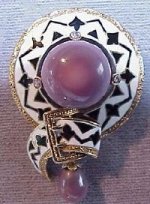jshepherd
Pearl Paradise
- Joined
- Jun 22, 2004
- Messages
- 6,344
In 2005 she started a quarter million dollar craze for a pearl worth a few thousand (if that). Since that time this forum's contact us page has been inundated with emails from people who have found a purple pearl and are hoping to cash in. It has been great for the quahog pearl business if you are selling, tough if you are buying - a lot of hopes and fantasies have been dashed since.
The Purple Pearl of Newport wowing the crowds"
By BRYAN ROURKE
The Providence Journal
March 22, 2005
The Purple Pearl went West and wowed the jewelry world.
The rare, enormous and potentially priceless purple quahog pearl acquired for $14 from a costume-jewelry basket in 2000 by Alan Golash of Newport, R.I., has begun its global publicity tour. When that ends at auction in about two years, experts say, the gem could command more than $1 million.
Early indications are encouraging.
Last month, Antoinette Matlins of Woodstock, Vt., author of "The Pearl Book: The Definitive Buying Guide" and keeper of Golash's find, attended the Tucson International Gem Show. It's the world's largest gem show, lasting two weeks and involving more than two-dozen jewelry organizations.
"Anybody and everybody from a gem-producing land was there," Matlins said.
The Purple Pearl was there, too, making its official debut.
"Everyone at the table went 'wooo,' " said Robert Weldon, senior writer at Professional Jeweler Magazine. "The reaction was certainly positive. Regardless of what it is, it's certainly an item of rarity."
The Purple Pearl isn't technically a pearl. Gemologists say pearls must come from an oyster or a mussel. Quahogs, however, are also capable of producing them, though rarely. Quahogs are thick-shelled edible clams.
"There's a handful of quahog pearls out there," said Gina Latendresse, president of the American Pearl Company in Nashville, Tenn. "That makes them very interesting and very rare. I don't know what will come of it."
According to Matlins, the jewelry industry's three largest magazines are all writing articles about the Purple Pearl. The Smithsonian Institute is considering including it in its "Natural Pearls" exhibit. The American Museum of Natural History is also reportedly interested in exhibiting it. And the SSEF Swiss Gemological Association is now conducting a scientific study on it, with a report expected next month.
Golash's partner, who wishes to remain anonymous, bought a brooch from a basket of costume jewelry at a former antiques shop in 2000. His partner recognized that the brooch was made of gold, Golash said, paid $14 for it and brought it home.
Golash, who professionally restores antique jewelry, cleaned the brooch, and verified it was made of 18-karat gold, enamel and three small rose-cut diamonds. Based on its construction and Victorian styling, it's believed to have been created between 1850 and 1875.
However, the brooch's most notable features are two purple pearls. Both are all-natural, not cultured with an implanted bead, as is the modern practice. And one of the pearls is huge, 14 millimeters, about twice the size of average rare natural pearls.
What makes this pearl even rarer is that it's purple. That's because it comes from a quahog, which doesn't often produce pearls, but when it does, purple's the color.
"No one knows what its value is," Matlins said. "Everyone (at the Tucson show) agreed it wasn't unreasonable to expect $250,000 without any promotion to make the world aware of it. And these are gemologists who are notoriously conservative."
Golash's pearl is insured, but Matlins won't disclose its appraised value.
For the next two years, Matlins said, the plan is to tour Golash's pearl in museums and traveling exhibits, then auction it in Hong Kong, where pearls are most prized.

